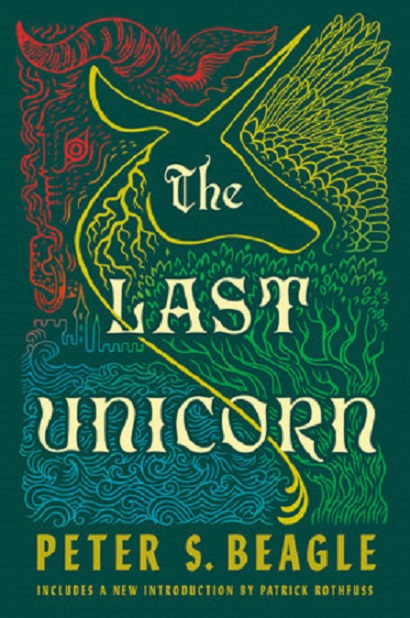Book Review: The Last Unicorn by Peter S. Beagle
The unicorn has been alone in her wood for a very long time. How long? Hard to say, as she is a naturally immortal being of a solitary nature. One day, she overhears from a hunter that she may be the last unicorn in the world. While she could stay safe in her forest indefinitely, it feels to the unicorn that she should go looking for her kin to confirm their disappearance. She wanders the human road for several seasons without finding any clues.

Eventually, a butterfly stops being nonsensical just long enough to indicate that something called the Red Bull may be responsible for the disappearance of the unicorns. The unicorn has learned that most humans have lost the ability to “see” unicorns, treating her as though she is merely a very beautiful horse. Thus she gradually lets her guard down and is captured by the hedge witch Mommy Fortuna.
Mommy Fortuna runs a traveling “monster” show; her illusions make the ordinary animals in most of her cages look like fabulous beasts. Only two of the exhibits are real, the unicorn…and the harpy. The harpy is dangerous and hateful at being held captive, and will kill Fortuna the moment she gets a chance, but the witch can’t help holding on to the monster just because she can. One of Mommy Fortuna’s assistants is the inept mage Schmendrick, who agrees to free the unicorn.
This doesn’t quite work the way Schmendrick had hoped, but the unicorn lets him travel with her as he knows that the Red Bull is associated with a King Haggard, who has a castle near the sea–somewhere.
After some more wandering, Schmendrick is captured by the bandit Captain Cully and his less than merry men. He lets his magic do as it will, and the true Robin Hood passes through the clearing with his phantom troupe, which the men chase after. Captain Cully ties Schmendrick up for this, and the wizard is freed by the unicorn. Cully’s leman Molly Grue recognizes the unicorn for what she truly is, and joins the journey, as she actually knows the way to King Haggard’s land. But even when they arrive, there will be great obstacles to overcome.
This 1968 novel is one of the all-time classic fantasy books. Despite his relative youth at the time, Peter S. Beagle captured a breadth of experience and layers of meaning that allow the book to be read over and over with new eyes.
Molly has long since lost her innocence and grown sharp-tongued, no longer a beautiful maiden. The older I get, the more I identify with her anguish that she only meets a unicorn now, long after it would seem relevant. Yet she retains the ability to see clearly, knowing a unicorn when she sees one. Molly also shows the value of “women’s work.” Lady Amalthea may be far more beautiful and awesome, but Molly’s the one who keeps people in decent food and redirecting them to the goal.
Schmendrick’s a smartass and a trickster with severe self-confidence issues. He has more power than even he guesses, but it does not work well for him, and letting it do what it wants drains him. He understands that he’s in a fairy tale and has a role to play, but does not always relish it. He does come across as a little too attuned to anachronism at times (as does the butterfly earlier in the book.)
The unicorn is satisfyingly alien–she thinks as well as a human, but not like a human, and becoming Lady Amalthea is much more of a curse than a blessing, however necessary it might be in the moment.
The Red Bull is more of a mystery, a force of nature whose relationship with King Haggard is never quite defined. It’s not so much defeated in the end as gone, with its fate unknown.
King Haggard as the antagonist is also somewhat trapped in his role. He has no actual joy beyond perhaps seeing what’s become of the unicorns, always wanting something, but never knowing what that actually is, so grasping all he can reach and hoarding it even though it brings him no happiness. His end is as much mercy as justice.
And then there’s Prince Lir, a spoiled, soft boy who becomes a hero for love of Lady Amalthea, but learns that heroism has its own price and logic. It takes him a long time to figure out how to deal with his desires as opposed to what is right.
The characters take turns being wise and foolish, and some are doomed by the narrative. There’s quite a few songs in the book, none of which seem to have made it into the movie version, which had its own songs.
Sadly, despite the sales of the book, and having written the screenplay for the also very popular movie, Peter Beagle was cheated of his royalties and residuals for many years. Support the unions to make sure that all workers get their fair share!
Content note: Mommy Fortuna keeps the animals in her show in cramped, filthy cages. Lir kills an awful lot of people and “monsters” off page. Parental abandonment (and a quick attempt to claim credit when the child still succeeds.) Due to the themes, it’s probably best for later teens and up.
This is a top ten fantasy novel. Or you could watch the movie, that’s good too. Recommended to fantasy fans.

